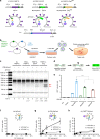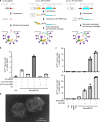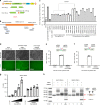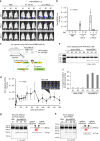Extracellular nanovesicles for packaging of CRISPR-Cas9 protein and sgRNA to induce therapeutic exon skipping
- PMID: 32170079
- PMCID: PMC7070030
- DOI: 10.1038/s41467-020-14957-y
Extracellular nanovesicles for packaging of CRISPR-Cas9 protein and sgRNA to induce therapeutic exon skipping
Abstract
Prolonged expression of the CRISPR-Cas9 nuclease and gRNA from viral vectors may cause off-target mutagenesis and immunogenicity. Thus, a transient delivery system is needed for therapeutic genome editing applications. Here, we develop an extracellular nanovesicle-based ribonucleoprotein delivery system named NanoMEDIC by utilizing two distinct homing mechanisms. Chemical induced dimerization recruits Cas9 protein into extracellular nanovesicles, and then a viral RNA packaging signal and two self-cleaving riboswitches tether and release sgRNA into nanovesicles. We demonstrate efficient genome editing in various hard-to-transfect cell types, including human induced pluripotent stem (iPS) cells, neurons, and myoblasts. NanoMEDIC also achieves over 90% exon skipping efficiencies in skeletal muscle cells derived from Duchenne muscular dystrophy (DMD) patient iPS cells. Finally, single intramuscular injection of NanoMEDIC induces permanent genomic exon skipping in a luciferase reporter mouse and in mdx mice, indicating its utility for in vivo genome editing therapy of DMD and beyond.
Conflict of interest statement
P.G. and A.H. are inventors on a filed patent (PCT/JP2019/027708) based on the delivery system, virus-like particle, production, and use for genome editing described here. Y.M., H.H., and N.I. are employees of Takeda Pharmaceutical Company. A.H. is a principle investigator (without salary) of the T-CiRA program funded by Takeda Pharmaceutical Company. All other authors declare no competing interests.
Figures






Similar articles
-
Preparation of NanoMEDIC Extracellular Vesicles to Deliver CRISPR-Cas9 Ribonucleoproteins for Genomic Exon Skipping.Methods Mol Biol. 2023;2587:427-453. doi: 10.1007/978-1-0716-2772-3_22. Methods Mol Biol. 2023. PMID: 36401042
-
Efficient ssODN-Mediated Targeting by Avoiding Cellular Inhibitory RNAs through Precomplexed CRISPR-Cas9/sgRNA Ribonucleoprotein.Stem Cell Reports. 2021 Apr 13;16(4):985-996. doi: 10.1016/j.stemcr.2021.02.013. Epub 2021 Mar 11. Stem Cell Reports. 2021. PMID: 33711268 Free PMC article.
-
Restoration of Dystrophin Protein Expression by Exon Skipping Utilizing CRISPR-Cas9 in Myoblasts Derived from DMD Patient iPS Cells.Methods Mol Biol. 2018;1828:191-217. doi: 10.1007/978-1-4939-8651-4_12. Methods Mol Biol. 2018. PMID: 30171543
-
Molecular correction of Duchenne muscular dystrophy by splice modulation and gene editing.RNA Biol. 2021 Jul;18(7):1048-1062. doi: 10.1080/15476286.2021.1874161. Epub 2021 Jan 20. RNA Biol. 2021. PMID: 33472516 Free PMC article. Review.
-
Points of View on the Tools for Genome/Gene Editing.Int J Mol Sci. 2021 Sep 13;22(18):9872. doi: 10.3390/ijms22189872. Int J Mol Sci. 2021. PMID: 34576035 Free PMC article. Review.
Cited by
-
Recent Advances in Extracellular Vesicles in Amyotrophic Lateral Sclerosis and Emergent Perspectives.Cells. 2023 Jul 1;12(13):1763. doi: 10.3390/cells12131763. Cells. 2023. PMID: 37443797 Free PMC article. Review.
-
Targeted Drug Delivery to ACE2+ Cells Using Engineered Extracellular Vesicles: A Potential Therapeutic Approach for COVID-19.Curr Pharm Biotechnol. 2025;26(3):443-454. doi: 10.2174/0113892010282251240324123038. Curr Pharm Biotechnol. 2025. PMID: 38551053
-
Directed evolution of engineered virus-like particles with improved production and transduction efficiencies.Nat Biotechnol. 2024 Nov 13:10.1038/s41587-024-02467-x. doi: 10.1038/s41587-024-02467-x. Online ahead of print. Nat Biotechnol. 2024. PMID: 39537813
-
Mesenchymal stromal cell exosomes for drug delivery of prostate cancer treatments: a review.Stem Cell Res Ther. 2025 Jan 23;16(1):18. doi: 10.1186/s13287-025-04133-8. Stem Cell Res Ther. 2025. PMID: 39849570 Free PMC article. Review.
-
Increasing Gene Editing Efficiency via CRISPR/Cas9- or Cas12a-Mediated Knock-In in Primary Human T Cells.Biomedicines. 2024 Jan 6;12(1):119. doi: 10.3390/biomedicines12010119. Biomedicines. 2024. PMID: 38255224 Free PMC article. Review.
References
Publication types
MeSH terms
Substances
LinkOut - more resources
Full Text Sources
Other Literature Sources
Molecular Biology Databases
Research Materials

